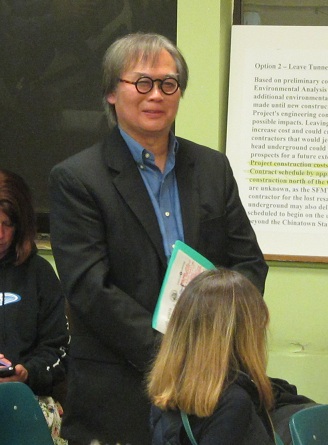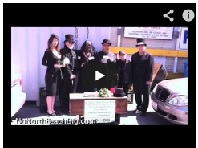Letters and studies by Howard Wong

|
| Howard Wong addressing April 17, 2013 neighborhood meeting with SFMTA |
North Beach: Lorenzo Petroni: Maestro of North Beach (1938-2014)
Lorenzo Petroni was one of those unique, bigger-than-life (and fast-disappearing) characters of North Beach and San Francisco. Like the late Ed Moose and the few rare galvanizing personalities, Lorenzo Petroni's magnetism constructed relationships, energizing North Beach as a hub of social, cultural and political interactions. Beyond ideology, he linked people through genuineness lubricated by bread, pasta and wine. Not shy, you knew where he stood — very effective in stopping the disruptive digging up of Columbus Avenue by the Central Subway. We should all be inspired to nurture North Beach's spirit, character and uniqueness — to honor the legacy of Lorenzo Petroni.
Life is too short for bad wine - so salute. — Lorenzo Petroni
Obituaries:
Chronicle: S.F. restaurateur Lorenzo Petroni dies at 75
Organic Wines Uncorked: Italian restaurateur and vintner Lorenzo Petroni dies.
Central Subway: Two Bites: Muni Service Cuts and Gentrification, April 2014
Protect Chinatown & North Beach & Muni!
Muni cuts, subways, land values and gentrification. Chinatown, North Beach, Telegraph Hill, Russian Hill and the Waterfront are Mediterranean-like villages. But their affordability, beauty, character and diversity are vulnerable to economic forces. In the Wall Street Journal: “Housing costs near rail stops increased after light rail service started.” (SEE BELOW)
As Muni cuts surface transit, developers push for costly subways. The Central Subway takes $595 million of state/ local matching funds from the Muni system—cutting service. With cost overruns, more service will be cut. (SEE BELOW)
Central Subway: Cooking the Books, April 2014
A report on the topics below compiled by Howard.
- Central Subway: Accounting Illegality
- SFWeekly: Covering Their Tracks: The Central Subway Project Buries Millions in a Deep Dark Place
- PMOC Reports: The independent PMOC (Project Management Oversight Consultant) analyzes the project for the FTA (Federal Transit Administration).
- SFWeekly: Shock and Awe: The Little Hybrid Engine That Couldn't
- Central Subway: A History of Data Falsification
Vigilance! Simple Muni Solutions: Best Practices in the World
September 2013: San Francisco's transit system doesn't have to be expensive and complex — we can follow the example of other successful transit systems in the US and around the world. They are simple and efficient. Howard illustrates this with links and YouTube videos in his full report here.
PAGODA THEATER DEMOLITION — UNSAFE & ILLEGAL
Email from: Howard Wong
To: hanson.tom@sfgov.org, dbicustomerservice@sfgov.org, tom.hui@sfgov.org, edward.sweeney@sfgov.org, cityattorney@sfgov.org, jack.song@sfgov.org, john.rahaim@sfgov.org, christine.haw@sfgov.org, Kevin.Guy@sfgov.org, buck.delventhal@sfgov.org, MTABoard@sfmta.com, Roberta.Boomer@sfmta.com, Ed.Reiskin@sfmta.com, cac@sfmta.com
August 20, 2013
Please forward this to appropriate parties.
TO: DBI, Planning, City Attorney, SFMTA, SF Office of Labor Standards, Central Police Station, OSHA, BAAQMD
RE: PAGODA THEATER DEMOLITION — UNSAFE & ILLEGAL
Property Address: 1731 Powell Street, Block/ Lot: 0101/ 004
Big hauling trucks are backing up next to pedestrians — without barriers. Only a cyclone fence separates walkways from construction work — in a heavy pedestrian and traffic area. There is no overhead protection for pedestrians and adjacent properties. Businesses are being impacted without SFMTA coordination or empathy — torn plastic sheeting, flying dust, noise, jack-hammering, closed sidewalks, trucks, hauling .. Construction workers are rude to neighbors and pedestrians — accosting an 80-year-old lady who asked questions.
Contrary to promises of work stoppage at 3:30 pm daily, demolition work is going over 10 hours a day — with large crews past 5 pm. Since at least July 11, 2013, SFMTA has distributed a North Beach/ Pagoda Fact Sheet (via emails, online & flyers), which states:
"Work Hours: Monday to Friday, 7 a.m to 3:30 p.m."
Businesses and residents have reported that work often continues beyond 5 pm daily.
Demolition work continues without: a posted Permit, normal public information, public notifications, appeals processes, independent inspections and routine safety measures — with demonstrable negative consequences.
Regards, Howard Wong, AIA
Central Subway Pagoda Theater Demolition: Unprofessional and Flying Bricks
Flying bricks and dust at the Pagodas demolition have raised more neighborhood anger — particularly when internal SFMTA documents deem the demolition is not even necessary (see below). The big excavator machine will cut the building into rubble, causing vibration and impact loads, which will destabilize brick walls at and adjacent to the site. The contractor has provided no bracing of the 1907 masonry walls, no lateral bracing of adjacent structures (especially the abutting 1907 brick warehouse), no shoring of adjacent buildings, no monitoring, no protective canopies/ scaffolding, no dust barriers, no noise abatement ... .
SFWEEKLY: "Pagoda Palace: Falling Bricks Land on Sidewalk Near Construction Site", 8-6-13
SFWEEKLY: "Pagoda Palace: Restaurant Owner Discovers Brick Fragments on Roof, Gets Angry", 8-7-13
VIDEO: Philadelphia Collapse — "Signs of Trouble Apparent Days Before Collapse"
SFWEEKLY: "The Canary is Dead: With the Central Subway Project, the Only Way Out is Through"
A recent U.S. Department of Transportation study of 10 major rail projects revealed an average cost-per-passenger 500 percent higher than the initial figures used to sell the idea. "It is certainly possible," the study concludes, "that decision-makers acting on more accurate forecasts of costs and future ridership ... would have selected projects other than those reviewed here."
SFMTA Is Not Above the Law — or Physics.
Citing little-known Charter authority, SFMTA is issuing its own Permit for demolition of a private property — without public reviews, permits, notifications and appeals. Avoiding permit enforcement and inspections, demolition work has proceeded without protective canopies, scaffolding, dust barriers and hazardous materials containment. Dust has dispersed into the air. Bricks have fallen onto sidewalks and adjacent roofs. Contrary to SFMTAs new physics, old bricks do not fall only in one direction.
SFMTA Does Not Have Charter Authority to Avoid City Permit and Planning Processes
Voters never intended for SFMTA to ignore public processes for permits, notifications and appeals.
SFMTA has never established a Permit Bureau, which enforces City codes, regulations and ordinances.
The City Charter requires SFMTA to comply with overarching local, state and federal codes and laws.
A City Department that leases a private property can not demolish said property — by merely posting an 8-1/2" x 11" letter that it has unilaterally written to approve demolition,
A City Department can not grant permits for its own Contractor — contracted through City bidding requirements and all its mandated legal obligations.
A City Department can not avoid independent inspections, public notification, posting, mailings to properties in 300-foot radius, due process and appeals.
- SFMTA and its Contractor must still comply with codes and requirements of the Department of Building Inspection
- SFMTA must comply with safety requirements and codes, e.g. building codes, fire codes, hazardous materials containment, noise ordinances, OSHA, BAAQMD .
- Contracts must provide pedestrian protection per the California Building Code and the SF Building Code (Chapter 33, "Safeguards During Construction") — including overhead canopies, scaffolding, plastic sheeting, barriers .
- Per code, for Type III Masonry Construction more than two-story high, special requirements include extra safety precautions, stabilization of brick walls, protection of adjacent properties, monitoring ..
- Independent inspection is required — not "The fox guarding the hen house" — to mitigate undue liability for SFMTA and the City.
Philadelphia developed strong demolition standards after its building collapse.
- Contractors and employees must have extensive experience — not the case for the Pagoda.
- A Site Safety Demolition Plan must be developed by a competent person — not the case for the Pagoda.
- REQUIRED: Inspection details on the structural conditions of adjoining properties.
- REQUIRED: Means and methods for protection of adjacent structures.
- REQUIRED: Demolition methods, potential hazards, underground utilities, safety/ environmental issues.
- "Demolition shall be performed by hand methods and shall be restricted to horizontal operations. The demolition shall proceed from top to bottom, one floor at a time."
- "No wall section more than one (1) story in height shall be permitted to stand alone without lateral bracing "
- "Masonry walls shall be demolished in small sections."
- "Structural members on any floor shall not be cut or removed until all stories above the floor have been demolished and removed."
- "The use of power-operated wrecking equipment may only be approved where a building or group of buildings is being demolished, and is detached from other structures not to be demolished." — not the case for the Pagoda.
- "The contractor shall maintain the integrity of the party walls and shall provide any and all shoring and bracing required for their support."
- Independent demolition inspections are required — not the case for the Pagoda.
Asbestos and Lead: Safety Precautions Ignored
Despite many requests, SFMTA has not identified hazardous materials to neighbors nor divulged abatement procedures. If any haz-mat removal has occurred, such work was done without any containment or protective barriers — throwing particulates into the air. Nearby residences and restaurants with outdoor dining have been ignored.
The "Phase I Environmental Site Assessment" (by "Ceres Associates", May 30, 2001) and "Asbestos and Lead Survey" (by "EnviroNova", June 19, 2009) identify lead (paint, tiles, soldered plumbing connections .), asbestos (roofing, mastic, flashing, plaster, putty, tiles .) and mercury (thermostats).
Risky Geotechnical Conditions
The Pagoda site has saturated sandy soils, a high water table and underground streams. Structural loads onto cavity-prone soils have high potential for soil subsidence and damage to adjacent buildings.
Independent Geotechnical Evaluations: "Karp Report 1, 2 and 3".
SFMTA Acknowledges That Project Is Not Necessary
The demolition is being rushed for political reasons. Internal SFMTA documents show that demolition is not necessary: In SFMTAs Risk Management Report No. 46, Risk Item 208 (pp 66–68) notes:
"March 2013: 2. If resolution of costs associated with the Pagoda option is not achieved, the TBMs will be buried to maintain budget requirements."
TBMs (Tunnel Boring Machines) can be buried under Stockton Street or extracted in Chinatown, eliminating the empty 2,000 foot tunnels from Chinatown to Washington Square and the Pagoda Project. Cost savings of up to $80 million can be used to quickly improve Muni throughout northern and western San Francisco.
Rushed Demoltion = Bad Consequences
The Pagoda Theaters rushed demolition is unwise and illegal. At minimum, surrounding business/ property owners should be allowed to review engineering and demolition procedures. Thus far, neighboring businesses and property owners have been left in the dark.
ABC-NEWS: "Philadelphia Building Collapse Inspector Commits Suicide"
NBC10 PHILADELPHIA: "Philadelphia Building Collapse"
USA TODAY: "6 dead, 14 hurt in Philadelphia building collapse"
ASSOCIATED PRESS: "Woman buried for 13 hours in Philly building collapse loses both legs"
NBC10 PHILADELPHIA: "Deadly Building Collapse in Pictures"
- Regards,
- Howard Wong, AIA
- SaveMuni.com
- /northbeach/
"Bay Bridge Bolts" at Pagoda site?
Pagoda Box Construction — Cutter Soil Mixing
From the June 13, 2013 Central Subway Risk Management Meeting, p. 19, Risk Item 208 says: "Cutter soil mixing is being proposed to construct the retrieval shaft in lieu of tangent piles (ROM approx. $600k less than tangent piles)."
Per below info on cutter soil mixing, this technique seems very risky — by churning existing soil and pumping wet cement into already saturated soils.
YouTube Video: Cutter Soil Mixing Technique
Cutter Soil Mixing:
http://forum.dwg.ru/attachment.php?attachmentid=7619&d=1213769084
http://www.jacobssf.com/images/uploads/havekost2_RETC2011.pdf
http://www.bauerpileco.com/en/products/bauer_bg/cutter_soil_mixing/
But Pagoda site has saturated sandy soils and a high water table, and is not suited for this construction method.
See independent Geotechnical Reports: "Karp Report 1, 2 and 3.
SFMTA Confirms that TBMs Can Be Buried
From the June 13, 2013 Central Subway Risk Management Meeting, p. 19, Risk Item 208 has a note:
- March 2013: 2. If resolution of costs associated with the Pagoda option is not achieved, the TBMs will be buried to maintain budget requirements.
So why spend $80 million in tunneling and tunnel boring machine (TBM) retrieval — for $4.4 million in TBM salvage value?
This confirms that the only reasons for not burying or extracting TBMs in Chinatown are:
- Build part of a future northern subway without environmental reviews, public processes or citizen participation.
- Construct two empty 2,000 foot tunnels from Chinatown to North Beach for non-existent Central Subway Phase 3 using Phase 2 operating funds.
- Prejudice future federal transportation rail investments because the northerly tunnel extension from Chinatown to North Beach predetermines an alignment.
- Drive up land values and development into northeast neighborhoods and waterfront — while Muni transit quality declines.
UPDATE: CENTRAL SUBWAY DEFICITS
SaveSFMuni blog, June 10, 2013
CENTRAL SUBWAY OVERBUDGET BY $ 400 MILLION+, May 17, 2013
SaveMuni.com Revision B May 15, 2013
CENTRAL SUBWAY OVERBUDGET: FISCAL CRISIS CONCEALED
Without the sunshine of independent audits, huge cost overruns for the Central Subway Project are being concealed---to force city officials and taxpayers into future debt loads.
According to the San Francisco Municipal Transportation Agency (SFMTA), all project contracts have been awarded or bid. Based on available data, contingency funds are now at insufficient levels or gone altogether---even before major construction begins for tunneling and deep excavations:
CENTRAL SUBWAY BUDGET ANALYSIS
Construction Contracts - attached: Total Project Budget and Contracts List
- Contingency Funds are under 3% of the project budget---when 20% is prudent.
- The largest construction contracts low bidder, Tutor Perini (Tutor Saliba) uses aggressive change orders. http://www.sfgate.com/bayarea/article/Low-bid-on-subway-station-could-cost-SF-3780385.php
- In 2009, the Federal Transit Administration (FTA) recommended a 20% contingency of $330,000,000.
- In 2009, the FTA projected a cost of $2,000,000,000 at 80th percentile confidence---requiring a contingency of $421,700,000.
- In the independent CGR Management Consultants Report, Munis major projects have exceeded budgets by an average of 39%. For the Central Subway, 39% equals a contingency of $615,500,000.
- Federal Sequester cuts in 2013 eliminated $7,700,000 from Central Subway Project http://www.sfgate.com/nation/article/Gridlock-means-U-S-spending-cuts-hit-home-4322132.php
- Litigation regarding State High Speed Rail Funds may eliminate $61,300,000 from the Central Subway http://www.examiner.com/article/former-chairman-declares-train-project-violates-the-law
Given the FTAs designation of the Central Subway as high risk and given the problematic history of tunneling, the Central Subway will go over budget by hundreds of millions of dollars.
Without full independent audits, hundreds of millions of dollars of cost overruns are being concealed---to force city officials and taxpayers into future debt loads.
- Partial audits have already uncovered illegal expenses by consultants: http://blog.sfgate.com/cityinsider/2013/05/02/central-subway-consultants-overbill-336000-including-cakes-parking-ticket/
- Audits are needed on subcontracts, soft costs (currently 23% of project cost), expenditures by city staff/ agencies and overhead rates (as high as 311%) taken by managers throughout SFMTA.
- Audits are needed on siphoning other projects funding and appropriations.
- SFMTA and city agencies are milking the Central Subways budget for wages---at the expense of project contingency funds.
MUNI SERVICE CUTS FOR YEARS TO COME
The Central Subway will absorb most of San Franciscos transportation capital budget for years to come, sacrificing essential transit projects. As required by the FTA, San Franciscos taxpayers will pay for all project cost overruns---with decreased Muni operating funds and service cuts.
- Cost overruns do not include the unnecessary Pagoda Theater Project, which is also going overbudget, taking at least $9.15 million from Muni operating reserves .
- SFMTA can save up to $80 million by burying, dismantling or extracting tunnel boring machines in Chinatown (like New York, Chunnel, Brisbane ) and deleting the 2,000 foot tunnels from Chinatown to Washington Square.
- These cost overruns are stunning, since the Central Subways budget has already increased from $647 million to $1.578 billion since 2003.
- Moreover, design cuts have reduced quality, shortened station platforms to maximum 2-car lengths (forever limiting passenger capacity), eliminated moving sidewalks, reduced fire exit paths .
Central Subway Has Already Cut Muni Service: To get local matching funds, the Central Subway has drained Munis operating/ maintenance funds----causing service cuts, route eliminations, deferred maintenance, crumbling infrastructure, missed runs, switchbacks, shorter holiday schedules, increased fares/ fees/ fines/ meters .
- In 2007, the new T-Line (Central Subway Phase 1) eliminated the 15-Kearny Bus/ 20 Columbus Bus and cut hours for the 41-Union Bus.
- In 2009-10, budget deficits led to 15%+ service cuts, including 6 discontinued routes, 16 shortened routes and reduced operating hours on 22 additional routes.
- If built, according to FEIR and FTA documents, the Central Subway will take $15 million annually from Muni operating funds and cut 34,000-76,000 bus hours/ year from the 8X, 30, 45 bus lines.
- With elimination of the T-Lines Embarcadero loop and direct connectivity to Market Streets BART/ Metro Stations, the Central Subway will cut transit service levels for hundreds of thousands of riders.
Central Subway a Development Deal, Not a Transit Project. Initially a political deal, the Central Subway is now driven by developers, real estate interests and the 1% who benefit financially---at the expense of Muni riders and taxpayers. Commuter links to Caltrain will drive up land values, development, gentrification, rents and evictions---hurting affordability, diversity, middle-class families and the Mediterranean quality of northeastern neighborhoods.
- For the Central Corridor Plan on Fourth Street, business associations are already lobbying for densities higher than proposed by the Planning Department.
- On October 9, 2008, the Planning Director and a Planning Commissioner held a Chinatown meeting for Rezoning Chinatown.
- The illegal 2,000-foot tunnels from Chinatown to North Beach sneak in part of a northern subway without environmental reviews and public processes---sacrificing fragile businesses for development.
If they build the Subway, it will ensure major, major new development at the stops in Chinatown and North Beach; and in terms of scale, these neighborhoods will never be the same again.
Allen B. Jacobs, Past SF Planning Director & Dean of UC Berkeley's College of Environmental Design
Abandon the wasteful Central Subway and Pagoda Theater Projects; Invest hundreds of millions of dollars into revolutionizing Muni throughout San Francisco. Follow examples of stopping the Embarcadero Freeway and Alaskas Bridge to Nowhere.
The Central Subways local funds and recovered federal funds (like Sarah Palin and the Bridge to Nowhere) can quickly create transit-preferential streets, pedestrian-bicycle enhancements, street beautification, robust commercial corridors and neighborhoods. By example, in 1973, Zurichs voters rejected an expensive subway project and voted instead to implement a less costly transit-priority program----leading to one of the worlds highest per capita ridership rates because its transit service is fast, frequent, reliable and inexpensive.
ZURICH: The Worlds Best Transit City: http://www.planetizen.com/node/53044
ZURICH STUDY:http://www.andynash.com/nash-publications/Nash2001-Zurich-PT-MTI-01-13.pdf
ZURICH VIDEO: http://www.youtube.com/watch?v=280mYXdci4w
Regards,
- Howard Wong, AIA
- www.SaveMuni.com
- http://savesfmuni.wordpress.com/author/zrants/
- /northbeach/
CENTRAL SUBWAY: LIABILITY AND HIGH CONSTRUCTION RISKS, April 1, 2013
THE SHIFTING OF UNFORSEEN COSTS TO CONTRACTORS AND TAXPAYERS
If the Central Subway Project is completed in 2019, most of today's politicians will be out of office — "immune" from any fiscal crisis left behind. The Board and staff of the San Francisco Municipal Transportation Agency (SFMTA) will avert personal liability. Legally-crafted construction specifications will shift blame to general contractors, subcontractors and suppliers — and cost overruns will fall to taxpayers. However, in matters of life-safety, political immunity from construction failures should not be so easily granted, particularly when basic engineering and physics have known consequences.
Are high risks known?
Yes. In the Federal Transit Administration (FTA) letter of 1-10-10 to the SFMTA:
"The Central Subway Project is a high risk project located in a densely populated urban center. It is the largest, most complex project ever undertaken by SFMTA."
The FTA has knowledge of past construction accidents (See "History of Accidents" below) and risky excavation in older areas of Downtown, Chinatown and North Beach. Unlike Hollywood Boulevard's sinkhole or Cologne's building collapse, the Central Subway is digging in narrower streets and in closer proximity to old buildings and shallow foundations — exacerbated by hilly terrain, underground water and saturated/ inconsistent soils.
What is the likelihood of construction cost overruns?
In the SF Weekly, 2-27-13,
"Central Subway: Muni's Drilling Plan Strains Credulity"
"An audit by the firm CGR Management Consultants pegged the likelihood of the Central Subway coming in on budget at 30 percent."
Even highly-developed countries with the best engineers have been stunned by construction accidents involving deep excavations and tunneling (See "History of Accidents" below). If the Central Subway goes over budget, the additional dollars will be taken from local Muni sources.
Have construction risks and liability been mitigated?
Not to the highest degree. Like the proposed Pagoda Theater excavation (See "A Case in Point" below), rudimentary assumptions have been made regarding geotechnical and building conditions. Nearby buildings have not had full structural analysis — only condition assessments. More pre-testing would reveal hidden aboveground and underground conditions. Standard construction procedures are insufficient, given the inconsistent soil conditions.
- For excavations underneath 100-year old buildings, into inconsistent soils with high water tables, basic physics can predict the immense forces that can stress structures, streets and utilities.
- The excavations' lateral proximity to existing structures increases the odds of soil subsidence and cavity formations, especially with sloping hills, intervening alluvial-filled valleys and fractured rock.
- Excavating to depths from 40-120 feet, the structural loading of saturated soils, combined with the dead loads of buildings and their contents, is large — prone to increased hydrostatic pressures, collapse of voids and soil subsidence.
- The 1906 Earthquake and Fire affected the narrow streets along the route of the Central Subway, leaving remnants of rushed demolitions, underground rubble, artificial fill and voids.
- Hilly terrain and alluvial valleys propel rainfall and underground water, saturating sandy soils, creating instability, vertical displacements ..
- Inconsistent soils are difficult to stabilize by compensation grouting alone, likely requiring expensive shoring, underpinning. slurry piles, tremie concrete construction ..
- Even in recent American tunneling projects, property owners have complained of noise, sewage floods, cracked foundations and other problems — much less catastrophic collapses.
Immediately after the disaster, rescue dogs began sniffing through the rubble.... Police immediately began searching for possible injured. The city's police...
Who will bear the risks, costs and liability?
The Central Subway's soft costs are over 23% of the project budget. While SFMTA staff use project funds for wages, a parallel consultant has been retained for project management (PM) — further shielding the City from liability. The PM consultant's contract minimizes its own liability. In a crisis, the City and its PM consultant will shift blame to design professionals and construction contractors.
The City's construction specifications, general conditions and contracts are crafted by City Attorneys to absolve the City of liability — loading liability on design professionals, general contractors, subcontractors and suppliers. Taxpayers will pay for cost overruns, resulting in decreased Muni operating budgets and transit service.
A Case in Point: The Pagoda Theater TBM Extraction
The SFMTA recently proposed extraction of Tunnel Boring Machines (TBMs) at the Pagoda Theater site. The Pagoda Project's public process and fragile geotechnical conditions are systemic of the Central Subway's overall approach. Much of hilly San Francisco has underground water/ streams, subsurface voids, rubble and inconsistent geological conditions — in addition to older buildings, brick foundations, shallow footings, seismic vulnerabilities and hidden conditions. Not all conditions have been studied.
- Merchants and property owners, adjacent to the Pagoda, have not been consulted on engineering plans — in order for their vetting of design adequacy, risks, rights and compensation for damages (operational and structural).
- The SFMTA's initial design includes an approximately 50'x50'x46' deep concrete TBM Retrieval Box, with 66' deep perimeter secant pile walls. The concrete box is within 18'-7" of the adjacent 1907 brick warehouse building.
- An independent geotechnical engineer submitted three letters, questioning the design's efficacy and warning of likely damage to adjacent buildings due to subsidence.
- In a Fee Proposal, the SFMTA's own engineering consultant confirmed that potentially adverse effects to adjacent structures, historic buildings and park properties due to ground movement, groundwater inflows, ground loss and settlement had not yet been analyzed — necessitating new geotechnical investigations.
- No nearby building has foundations or basements deeper than 10 feet below grade.
- No part of the 46-foot excavation will likely be in competent bedrock, digging 36 feet below the groundwater table.
- There are inadequate geological/ structural studies of adjacent properties and historical studies of the region.
- Underground springs flow from Russian Hill under the Pagoda Theater and adjacent buildings. Before 1906, on Filbert near Columbus, there once stood the "Palace Baths", which tapped into underground springs. In the past, neighbors could hear rushing water underground.
- The previous Muriel's Theater project at the Pagoda encountered underground water, increasing construction costs. Also, removal of gas tanks at the old corner gas station hit underground water.
- On Stockton Street at Washington Square, construction for Moose's Restaurant encountered underground springs from Telegraph Hill, which flooded neighborhood basements periodically. A workman in the dark basement dropped a tool and heard a splash. His light revealed that he had just missed falling 20 feet into a well.
- The nearby North Beach Pool subsided because of an underground stream, leading to a 2005 structural retrofit.
History of Accidents: Deep Excavation and Tunneling
Relative to other construction techniques, deep excavation and tunneling have extensive failures — especially at sites with older buildings, fragile geological conditions, soil inconsistency, underground water and seismic vulnerabilities. As required by the Federal Transit Administration, all cost overruns are the responsibility of the City & County of San Francisco and its contractors and subcontractors.
LOS ANGELES: Subway sinkhole collapses Hollywood Boulevard.
COLOGNE: Historical Archives Building collapse with two dead:
SEATTLE: Large sinkholes above TBM sewer tunnel.
SAO PAULO: Subway's deadly collapse with seven dead.
CAIRO: Downtown TBM Tunnel Collapse:
KOREA: Incheon Subway tunnel collapse with one dead.
GUANGZHOU: VideoSubway construction sinkhole swallows entire building complex.
BUDAPEST: TBM hits unknown water pipe, causing shaft collapse.
BUDAPEST: Highway tunnel collapse and scandal.
TAIWAN: Taipei Expressway tunneling had eleven collapses with twenty-five deaths.
STUTTGART: Tunnel sinkhole and nine dead.
TORONTO: TBM tunnel collapse.
PORTO, PORTUGAL: Three TBM tunnel collapses with one death in house collapse.
Are there fiscally prudent alternatives?
Taxpayers, designers and builders need to assure due diligence to protect their own interests. Existing and hidden conditions require thorough analysis. Project contingencies must cover cost overruns. The City's underlying politics is to construct 2,000 foot tunnels for the northerly subway extension — -without environmental reviews. Business associations and real estate interests want to escalate land values and large development prospects. But fiscally prudent alternatives exist to conserve funds. The SFMTA plans to spend $9.15 million from its operating funds for the Pagoda Theater Project, in order to retrieve two TBMs valued at $4.4 million. Moreover, the twin 2,000 foot tunnels from Chinatown to North Beach will cost up to $70 million. If the TBMs are extracted or buried at the Chinatown Station, SFMTA can save $79 million — better spent on construction contingency and Muni service enhancements.
Regards,
Howard Wong, AIA
North Beach residents and SaveMuni.com legal challenge to use of Pagoda Site for TBM extraction
In February 2013, Thomas N. Lippe of the law firm Lippe, Gaffney, Wagner was hired to write a series of letters opposing the use of the Pagoda Site for tunnel boring machine (TBM) removal. Geotechnical engineer Lawrence B. Karp provided supporting evidence that the soils at the site were too unstable to allow a TBM extraction shaft to be constructed.




